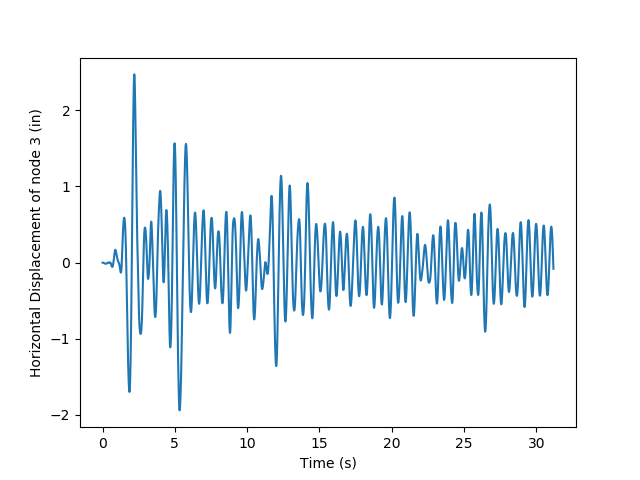14.2.2. Reinforced Concrete Frame Earthquake Analysis¶
The source code is shown below, which can be downloaded
here.The file for gravity analysis is also needed
here.The ReadRecord is a useful python function for parsing the PEER strong motion data base files and returning the
dt,nPtsand creating a file containing just data points. The function is kept in a seperate filehereand is imported in the example.The ground motion data file
heremust be put in the same folder.Run the source code in your favorite Python program and should see
Passed!in the results and a plotting of displacement for node 3

1print("==========================")
2print("Start RCFrameEarthquake Example")
3
4# Units: kips, in, sec
5#
6# Written: Minjie
7
8from openseespy.opensees import *
9
10import ReadRecord
11import numpy as np
12import matplotlib.pyplot as plt
13
14wipe()
15# ----------------------------------------------------
16# Start of Model Generation & Initial Gravity Analysis
17# ----------------------------------------------------
18
19# Do operations of Example3.1 by sourcing in the tcl file
20import RCFrameGravity
21print("Gravity Analysis Completed")
22
23# Set the gravity loads to be constant & reset the time in the domain
24loadConst('-time', 0.0)
25
26# ----------------------------------------------------
27# End of Model Generation & Initial Gravity Analysis
28# ----------------------------------------------------
29
30# Define nodal mass in terms of axial load on columns
31g = 386.4
32m = RCFrameGravity.P/g
33
34mass(3, m, m, 0.0)
35mass(4, m, m, 0.0)
36
37# Set some parameters
38record = 'elCentro'
39
40# Permform the conversion from SMD record to OpenSees record
41dt, nPts = ReadRecord.ReadRecord(record+'.at2', record+'.dat')
42
43# Set time series to be passed to uniform excitation
44timeSeries('Path', 2, '-filePath', record+'.dat', '-dt', dt, '-factor', g)
45
46# Create UniformExcitation load pattern
47# tag dir
48pattern('UniformExcitation', 2, 1, '-accel', 2)
49
50# set the rayleigh damping factors for nodes & elements
51rayleigh(0.0, 0.0, 0.0, 0.000625)
52
53# Delete the old analysis and all it's component objects
54wipeAnalysis()
55
56# Create the system of equation, a banded general storage scheme
57system('BandGeneral')
58
59# Create the constraint handler, a plain handler as homogeneous boundary
60constraints('Plain')
61
62# Create the convergence test, the norm of the residual with a tolerance of
63# 1e-12 and a max number of iterations of 10
64test('NormDispIncr', 1.0e-12, 10 )
65
66# Create the solution algorithm, a Newton-Raphson algorithm
67algorithm('Newton')
68
69# Create the DOF numberer, the reverse Cuthill-McKee algorithm
70numberer('RCM')
71
72# Create the integration scheme, the Newmark with alpha =0.5 and beta =.25
73integrator('Newmark', 0.5, 0.25 )
74
75# Create the analysis object
76analysis('Transient')
77
78# Perform an eigenvalue analysis
79numEigen = 2
80eigenValues = eigen(numEigen)
81print("eigen values at start of transient:",eigenValues)
82
83# set some variables
84tFinal = nPts*dt
85tCurrent = getTime()
86ok = 0
87
88time = [tCurrent]
89u3 = [0.0]
90
91# Perform the transient analysis
92while ok == 0 and tCurrent < tFinal:
93
94 ok = analyze(1, .01)
95
96 # if the analysis fails try initial tangent iteration
97 if ok != 0:
98 print("regular newton failed .. lets try an initail stiffness for this step")
99 test('NormDispIncr', 1.0e-12, 100, 0)
100 algorithm('ModifiedNewton', '-initial')
101 ok =analyze( 1, .01)
102 if ok == 0:
103 print("that worked .. back to regular newton")
104 test('NormDispIncr', 1.0e-12, 10 )
105 algorithm('Newton')
106
107 tCurrent = getTime()
108
109 time.append(tCurrent)
110 u3.append(nodeDisp(3,1))
111
112
113
114# Perform an eigenvalue analysis
115eigenValues = eigen(numEigen)
116print("eigen values at end of transient:",eigenValues)
117
118results = open('results.out','a+')
119
120if ok == 0:
121 results.write('PASSED : RCFrameEarthquake.py\n');
122 print("Passed!")
123else:
124 results.write('FAILED : RCFrameEarthquake.py\n');
125 print("Failed!")
126
127results.close()
128
129plt.plot(time, u3)
130plt.ylabel('Horizontal Displacement of node 3 (in)')
131plt.xlabel('Time (s)')
132
133plt.show()
134
135
136
137print("==========================")